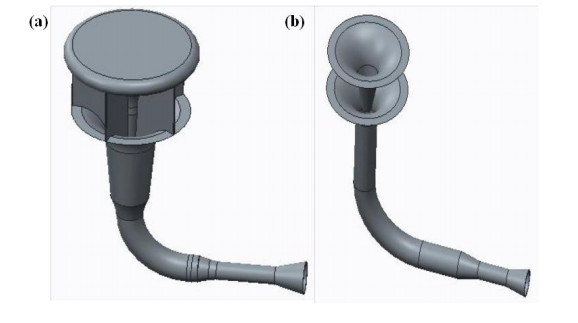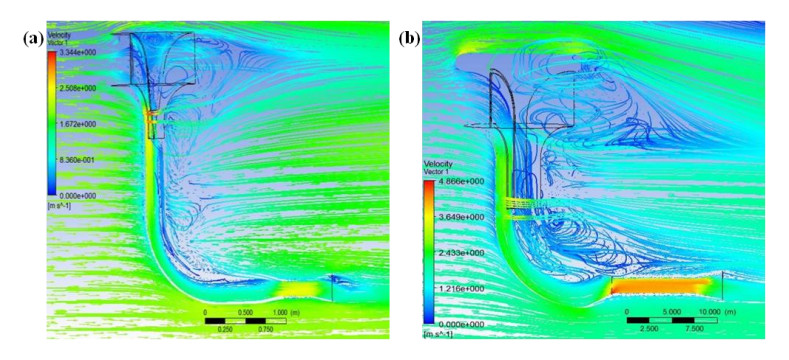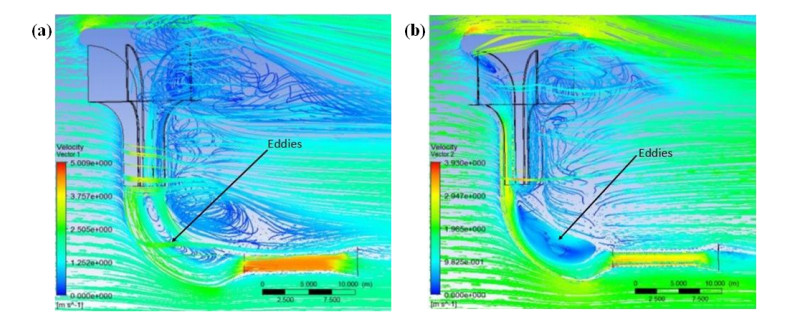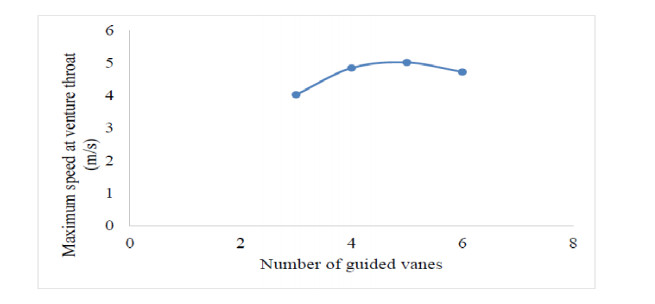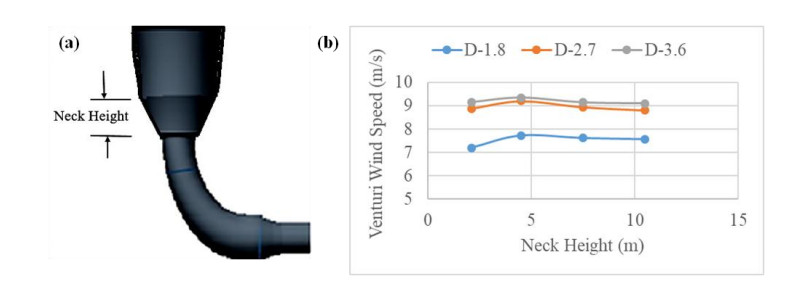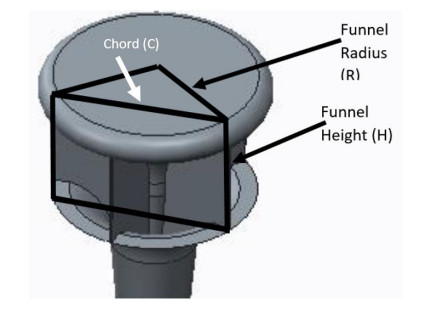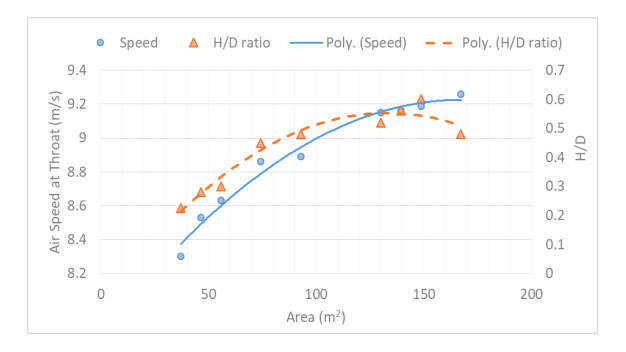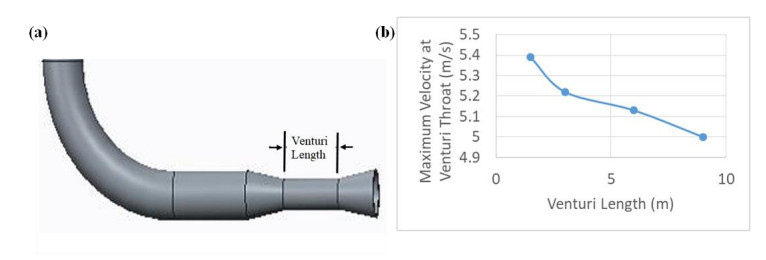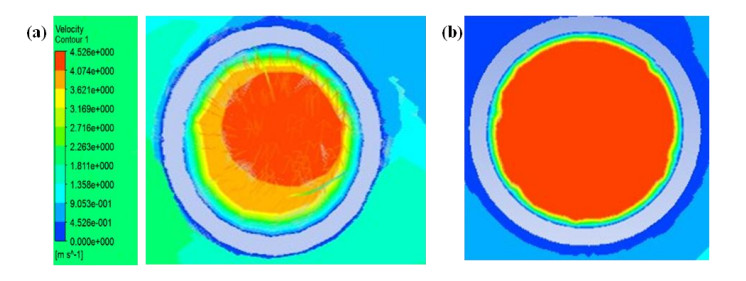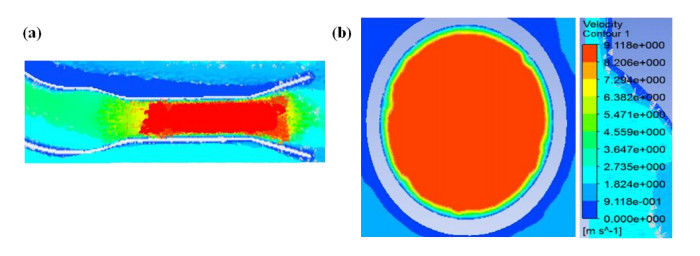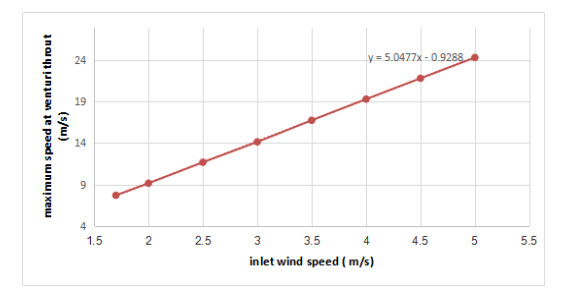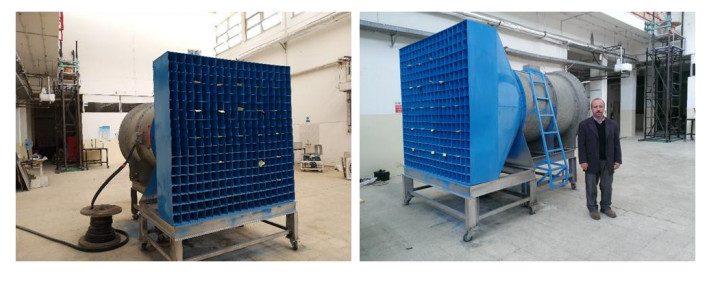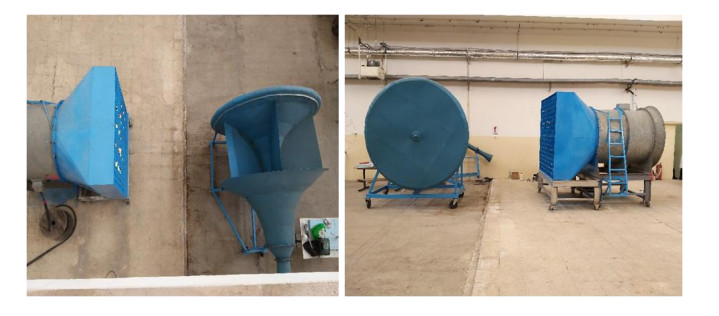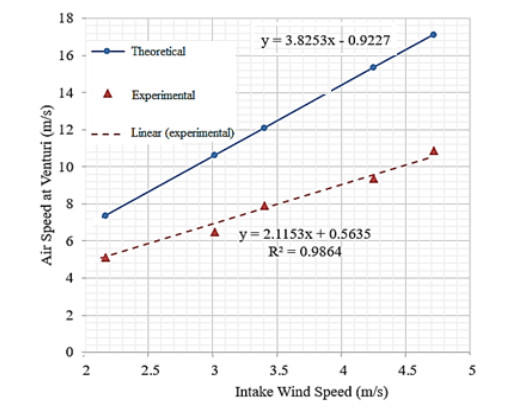Wind Funnel Concentrator System captures wind flow from any direction, funnels it down using tapered pipes leading to a concentrator that ends in Venturi section where the turbine should be placed. This Wind Concentrator system is called INVELOX machine. Parametric design analysis is carried out to obtain the optimum design parameters of the Wind Concentrator to maximize the wind speed at the venturi section. The parameters considered are the intake shape and size, guided vanes number and their length, elbow size, venturi length, and wind direction. The design and simulation is carried out using ANSYS software package. Results show that the intake area is directly proportional to venturi air speed, and is inversely proportional to the size of the venturi cross sectional area as well as the venturi cross section length. The highest venturi air speed is obtained when the system body orientation is aligned with the wind direction within a tolerance of +/-45°. The best performance achieved when the final shape of Wind Concentrator has five guided vanes extended to the end of the funnel length. The Velocity of wind at the Venturi throat is found to increase by more than four times of the intake speed.
1.
Introduction
Tropical regions or near tropic regions are characterized in general by low wind speed regions. The Hashemite Kingdom of Jordan, according to the average wind speed is considered in general as low average wind speed region even though it has some places that are rich of wind especially in mountainous areas. The challenge is to find a way to harvest energy from low wind speed profile regions. Similarly the urban areas where large objects such as buildings exist also have low wind speed profiles.
One of the most recent systems used to harvest wind power is by accelerating wind speed is the INVELOX machine. This system works based on capturing wind from all directions and tunneling it through convergent-divergent nozzle where wind turbine is located at its throat leading to an increase in wind velocity. Allaei & Andreopoulos [1] introduced the INVELOX. They achieved the goal of INVELOX as they have achieved double wind speed at Venturi throat. Allaei et al. [2] studied the INVELOX machine with multiple wind turbine generator systems. The results show that it is possible to harness more wind power using multi-stage turbine than single turbine. According to the results two turbines produce approximately 1.5 times the power of produced by single turbine whereas three turbines produce 1.7 times the power of produced by single turbine. This funneling concept is also introduced by Kumara et al. [3]. According to their experimental results, they have achieved increase of the wind speed at the venturi by 1.8 to 3.22 times of the intake wind speed. Anbarsooz et al. [4] introduced a curtain to reduce the wind escaping from the opposite side of the wind entering INVELOX. They reported 25% increase of the wind speed at the venturi for intake wind speeds of 3-12 m/s. Sotoudeh et al. [5] have introduced double funneling system (two story funneling). They reported 44% increase of power of using two-story funneling system compared to single story system (INVELOX). Summary of different types of wind concertation and wind accelerating systems can be found in this website WindMan [6].
Design of an optimum wind concentrator system that can harvest wind energy from any direction, concentrated it and deliver it through venturi benefiting from wind catcher technology is the main objective of this research.
2.
Methodology
This study focuses on designing wind concentrator system that is capable of harvesting energy from low wind speeds. Three main aspects related to wind speed through venturi, which represent the throat of the wind concentrator, will be taken into consideration which are:
A—Accelerating the wind speed as much as possible.
B—Generate uniform wind flow distribution through the system and mainly through venturi where the wind turbine shall be placed.
C—Make the geometry as compact as possible.
An academic version of ANSYS for mechanical systems will be used to carry out the design optimization for the system, once the optimum design is reached, scaled model shall be built to verify experimentally the obtained simulation result.
3.
Physical model
This section explains the initial physical model of Wind Concentrator. This model is geometrically modeled using Creo software. The initial physical model is shown in Figure 1 below labeled with important parameters.
The dimensions stated in reference [1] are used to primarily study the Wind Concentrator performance and find out how to improve such design to have better performance.
Wind Concentrator principle of work based on catching wind from all directions through guided vanes provided at inlet without any need to direction control system. Air will flow through an elbow (duct) till it reaches the converging part of the Venturi i.e. the nozzle. Due to area reduction, the wind speed will reach its maximum at the Venturi throat where turbines are intended to be placed. This leads to an increase in its kinetic energy and consequently, the power generated. Finally, air will be discharged from Wind Concentrator to atmosphere through diverging part of venturi i.e. diffuser.
Geometric parts of basic Wind Concentrator shape as shown in Figure 1 are as the following:
— Intake height (H): it represents the vertical distance between the upper and lower funnel. This allows air mass to enter the system.
— Upper funnel (UF): it represents the upper funnel of Wind Concentrator that extends down inside the lower funnel.
— Lower funnel (LF): it represents the lower funnel of Wind Concentrator where air mass flow through the annular between the upper funnel and the lower funnel.
— Radius of curvature (RC): it represents the radius of the curved elbow (duct). It connects the lower funnel with the Venturi section.
— Venturi length (VL): it represents the length of venturi (converging-diverging nozzle) throat.
— Venturi throat diameter (VD): it is the diameter of venturi cross section area.
— Convergent diameter (CD): it represents the venturi entrance diameter.
— Divergent diameter (DD): it represents the venturi exhaust diameter.
— Outer diameter (OD): it represents the outer diameter of upper and lower funnel, as both have the same value.
— Converging part length (CL): it represents the horizontal distance of the venturi convergent part.
— Diffuser part length (DL): it represents the horizontal distance of the venturi diffuser part.
4.
Simulation model
The Shear Stress Transportation (SST) model is adopted for the air flow through the system. The air density is consider to be 1.225 kg/m3 and the dynamic viscosity is considered to be 1.81 × 10-5 kg/(m. s). The mesh is decreased in size till the difference in the results is within 2%. The model is validated against well known cases in the literature, e.g. air flow in circular ducts and the difference in the results is within 5%. The Geometry of the physical developed in Creo Software and imported to ANSYS Software. The material selected for the geometry is steel. The boundary condition are chosen as the following: wall surface body condition is stationary wall, wall roughness is 0.5, turbulence intensity is 5%, turbulent viscosity ratio is 10 and the intermittency is 1. The convergence criterion is achieved when the variation in the velocity between successive iterations is 0.1%.
5.
Procedure
The major steps of carrying out this work are described in this section. All simulation analysis are conducted using both Creo software package for geometric modeling and ANSYS for simulation analysis.
5.1. Basic model
A basic geometric model shown in Figure 1 according to reference [1] work is remodeled using Creo software and analyzed using ANSYS software. This model is studied to have primary idea about the aerodynamics of the wind flow over and through the system, and explore the opportunity of improving such design for better performance.
5.2. Guided vanes
The first part that the wind strikes is the guided vanes. They are an important parameter because they guide the wind through the whole systems. Based on the analysis of the basic model it is found that there is a need to investigate the following issues:
a. Extend of the Guided Vanes: As the main goal of having guided vanes is to guide the air through the system so two types were considered, long guided vanes that continues through the space between the upper and lower funnel to the end of the funneling annular, and short guided vanes that do not reach the end of the funneling annular.
b. Number of Guided Vanes: three, four, five, and six guided vanes are investigated.
5.3. Upper funnel and lower funnel
These two funnels are the main parts of the whole Wind Concentrator and the distance between them is the intake height. They are the boundaries for the guided vanes. These funnels have the same diameter. The basic design has sharp lips for both the lower and the upper funnel. It is found that these sharp edges allow high percentage of wind to bypass the intake area. So a lip is introduced for the upper funnel and designed in order to trap more air mass. Also the top cavity of the upper funnel is closed to reduce the turbulence, by pass wind and prevent rain accumulation.
5.4. Intake height
The intake height is the vertical distance between the upper funnel and the lower funnel. This height is varied while keeping the intake area constant.
5.5. Tunneling
The ratio of the elbow bend diameter to its cross section diameter is studied.
5.6. Venturi length
It is the heart of the system where the accelerated wind is going to be utilized. Different lengths of the Venturi are investigated.
5.7. Wind direction
A relation between the intake wind direction within a tolerance of +/- 45° and air velocity at venturi throat is investigated. This tolerance matches the dominant directions of the wind flower in The Hashemite Kingdom of Jordan.
5.8. Wind velocity
Simulation analysis using ANSYS for all cases is carried out to find the relation between the wind speed at intake and at Venturi for all above design issues.
5.9. System sizing
For experimental validation for the results a scaled model needs to be built to fit the laboratory experiment setup. So the best performance design achieved is scaled to perform experimental validation analysis.
5.10. System implementation
Selecting the suitable size according to the cost and weight and selecting the material to build it for experimental validation.
6.
Results and discussion
Figure 2a shows improved design of the Wind Concentrator machine whereas Figure 2b shows the original design introduced by Allaei & Andreopoulos [1]. The design improvements that are made are as the following:
6.1. Round lip and top cover
Round lip for the upper funnel as well as a top cover is added to reduce the turbulence and the bypass wind. The Figure 3 shows the aerodynamics before and after the improvement. The improvement in the wind speed at the throat for the case with rounded lip and top cover is found to be 60% in reference to the case without rounded lip and cover. The speed at the throat has increased from 2.5 m/s for the case without lip and cover to 4 m/s for the case with lip and cover for reference intake wind speed of 2 m/s. As it may be seen in the Figure 3b more air mass is flowing into the funnel for the design that is equipped with rounded lip and cover.
6.2. Guided vanes
The effect of the extent of the guided vanes inside the funnel is investigated. The best scenario is found to be when the vanes are extended to the bottom end of the upper funnel. Sample cases for extended and none extended vanes is shown in Figure 4 It is found that the air speed increases from 3.93 m/s to 5 m/s for reference intake speed of 2 m/s. The increase in the speed is 27.5 % compared to short guided vanes. For long guided vanes the air is more streamed with little volume of eddies compared to short guided vanes where huge volume of eddies is taking place. Also in the short guided vanes Figure 4b, it can be seen that good amount of back flow air is escaping the back side of the funnel to the atmosphere. This issue is addressed by reference [4].
Analysis is carried out to investigate the effect of the number of the guided vanes on the performance of the wind concentrator. It is found that the best performance occurs when the system has five long guided vanes as shown in Figure 5.
The Wind Concentrator that consists of five guided vanes with the guided vanes oriented in same direction of the wind will be carried for further investigation. Unfortunately, a lot of swirling and turbulences can be noticed through the funneling system due to the sudden change in the cross-sectional area between the lower funnel and the elbow. To solve this problem the air passage area between the funnels should be gradually decreased till it matches the elbow (bend) cross-sectional area. Adding a neck between lower funnel and elbow with proper slope is needed to provide gradual decrease in the cross sectional area to overcome the turbulence and eddies caused by the sudden change in cross sectional area.
6.3. Variation in the neck
The neck is that part located between lower funnel and elbow as shown in the Figure 6. The main objective of the neck is to give gradual decreased in cross sectional area from the point at which upper funnel end to the top of the elbow.
Neck length, was taken to be 2.1, 4.5, 7.5 and 10.5 m. to study the effect of neck length on air velocity in cases if the diameter of the top of neck was taken to be 1.8, 2.7, and 3.6 m. The cases of diameter 2.7 m and 3.6 m for height of 4.5 m show the best performance, i.e. the inclination angle with vertical axis should be in range of 30 to 45 degrees.
6.4. Variation in intake area
The intake area is function of the funnel diameter and the intake height. Since the optimum number of vanes is 5, the opening angle of wind for each cell is 72°. Most of the time two cells are facing the wind as shown in Figure 7. The height of each cell is denoted by H whereas C is the projected width of two cells. C is the chord length of a circle that represent the funnel diameter. So the length C = D * sin (144°/2), where D is the funnel diameter.
Figure 8 shows the optimum H/D ratio (intake Height to funnel Diameter ratio) for different intake areas where the maximum air speed occurs at the correspondent intake area. It is obvious that the optimum H/D ratio increases as the area increases till it reaches area of 148.7 m2 then it starts to decrease. Also the maximum air speed increases as the intake area increases. In both trends that increase is not linear. This is due to the complex aerodynamic behavior of the wind flow through the funneling system.
6.5. Variation in venturi length
Venturi length shown in Figure 9a is varied from 1.5 to 9 m. Figure 9b shows the variation of the air speed with the venturi length. It can be seen that as the venturi length increases the speed decreases. However the velocity magnitude is not the only parameter which must be considered, the quality of the air flow is very important. The uniformity of air inside venturi throat is as important as air speed. For short length venturi the velocity of the air over the cross section is not uniform but for long enough venturi the velocity is uniform over the whole cross section as it can be seen from Figure 10. This loss of speed is in favor of the uniformity of the air flow. The reduction in the air speed for lengths between 1.5 m to 6 m is about 0.09 m/s. This is a small amount to sacrifice in favor of air quality that is going to hit the turbine. Another benefit for long venturi is installing more than one turbine in the venturi to harvest more wind power. This issue is addressed by Allaei et al [2].
6.6. Wind direction
The effect of wind blowing direction is also investigated. It is found that whatever the wind blowing direction is, it doesn’t affect the Wind Concentrator performance. The maximum speed is still achieved as well as the air quality at the throat.
6.7. Final design of wind concentrator
In this section, final improvements on Wind Concentrator shape will be shown. Simulation results based on final shape of the wind Concentrator will be shown as well. The simulation of the maximum velocity achieved at intake area of 1800 m2 shown in Figure 8 is illustrated in Figure 11. In this case all the design issues are considered and implemented. The uniformity of the flow through the system is obvious as well as in the venturi cross section.
The relation between the intake air speed and throat speed is shown in Figure 12. The relation between the speeds is linear, as the intake speed increases the speed at the throat increases. This is a logic results that satisfies the conservation of mass principle.
7.
Experimental results
The physical model of Wind Concentrator is resized according to its volume keeping the ratio of the dimension of each design parameter with respect to the venturi cross section diameter fixed for both the main design and the scaled design. Simulation analysis is done to obtain the data needed for experimental validation. The throat air speed for different intake air speeds are collected.
The design is implemented using sheet metal work. The sized wind concentrator has 0.3 m throat diameter section. Experimental setup of wind generator (wind blower) is shown in Figure 13.
Wind Concentrator machine can be made using any material that satisfies the main goal of this machine, such as fiber, tarpaulin, wood, sheet metal etc. The material should be strong enough to keep its shape as the air passes through the system. Sheet metal is chosen for this model because it’s relatively low cost and it is available in the local market. Figure 14 shows top view and side view photos for both the wind concentrator and the wind generator.
The experimental setup shown in Figure 14 is utilized to collect the air speed measurement at both the entrance of the wind concentrator and the venturi middle section. The blowing wind speed is controlled by the wind generator (wind blower) using variable frequency drive. Table 1 present the simulation and the measured speeds at the middle of the venturi section in m/s.
The relative difference between the theoretical and the experimental wind speed is ranging from 30% to 39% as it can be seen from Table 1. The experimental results show very good trend agreement with the simulation results. The difference can be referred to the manufacturing of the system. The three dimensional curvature of the funnel is manufactured as linear conical pieces welded together rather than being continuous smooth curvature. This means that there is corners between the successive sections of the system. These corners are favorite places for vortex generators that reduces the smooth stream flow of the wind. Similarly, the elbow is manufactured from linear pieces welded together to form its three dimension shape. So these non-smooth surfaces consume good amount of the wind kinetic energy.
Figure 15 shows the wind speed achieved in the venturi section by simulation and experimentally using wind generator. It is obvious from Figure 15 that as wind speed increases the effect of these issues increases, where the error at 2.17 m/s speed is 30% and reaches 39% at speed of 4.72 m/s.
8.
Real life model considerations
According to Figure 12 for wind speed of 5 m/s the wind speed at the venturi throat reaches 24 m/s. This huge increase in the intake speed i.e. it is approximately five times the intake speed. The rated power speed for micro-wind turbines is ranging from 10-12 m/s. Such huge size of the funnel concentrator is not necessary which means quarter scale model should get the turbine that is going to be placed at the venturi throat to reach its rated wind speed. Funnel concentrator of intake area of 2 to 3 times the venturi section area should provide the rated capacity of the turbine that is going to be placed at the venturi throat. If the turbine rated power 1 kW at a rated speed of 10 m/s then this full capacity will be achieved with a wind concentrator that achieve twice the average wind speed of 5 m/s.
This wind concentrator is recommended for areas of average wind speeds ranging from 4 to 8 m/s. Below this wind speed range needs huge size wind concentrator to reach rated wind speed and above this range the wind concentrator is not necessary since the extra cost will make it economically not feasible.
Fiber reinforced composite material is a recommended material and construction technique since it is light in weight and relatively easy to construct. Such construction technique is economically feasible since each mold can be used to produce hundreds of concentrator models.
9.
Conclusions
Wind Concentrator is suitable for harvesting wind energy in low wind speed regions as it accelerates the wind in the Venturi section, thus it will generate more power than other wind energy systems under the same conditions. The Wind Concentrator can capture and accelerate wind, not being affected by the direction of the wind as it does not affect the system performance. An additional advantage of using Wind Concentrator is that it is a static device with no moving parts except ducted turbines that are placed inside the Venturi throat near the ground that makes them easily accessible for maintenance.
The length of guided vanes played a major role in air speed and uniformity. Long guided vanes reduce air speed but more guidance and uniformity to the air stream. Whereas short guided vanes have less guidance of air streams and a lot of air mass bypass and escape out of the funneling annular. The longer the guided vanes extended inside the funnel the more uniform the air stream will be. The long guided vanes collect more air mass that increase the air speed at the throat in spite of the speed reduction due to the friction losses in the duct. The guided vanes should be extended to the end of the upper funnel which ends at the start of the elbow to ensure uniformity of the air stream.
Five guided vanes are found to have the best performance, i.e. the opening angle of the intake air is 144°. The performance of the wind concentrator is not affected by the wind direction as long as the wind concentrator body is aligned with the wind dominant direction with a tolerance of -/+ 45° according to wind flower of the location where the system is going to be installed.
To have a smooth air flow and eliminate the turbulences in the elbow, its radius of curvature should be two and half times the tunnel diameter. Also the cross-sectional area of the elbow should be 0.457 of the cross-sectional area confined between the lower funnel and inside extension of the upper funnel.
The turbines should fit inside the Venturi diameter and for that reason the Venturi diameter is limited to the turbine swept area diameter. Moreover, wind turbines can be placed in series along the Venturi length, this helps increasing the energy generated as long as the wind still has enough kinetic energy to exhaust.
The major design issue that should be considered is avoiding the abrupt change in the air passage area at the end of the upper funnel. This will prevent the huge loss in wind kinetic energy and keep wind accelerating. This makes the static pressure of the wind at the end of upper funnel section less than the pressure outside the wind concentrator. This sucks the air from the other openings of the opposite side of the funnel i.e. because of the vacuum generated due to the air acceleration through the funnel.
Upper funnel has a cover and a lip that allow the system capture more air mass and reduce the turbulence that is generated due to the sharp edges.
Theoretically the design issues considered in this research have improved the wind concentrator performance to achieve 4.6 times increase in wind speed at the venturi of the intake speed whereas for the scaled model is 3.6 times.
Finally, applying an optimum Wind-funnel Concentrator system into residential buildings especially in urban area reduces energy requirements thus reduces its cost and greenhouse gas emissions.
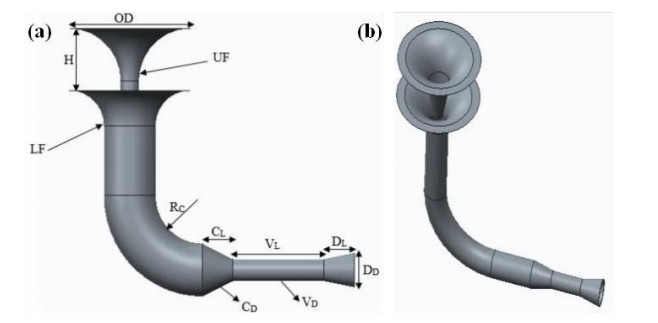









 DownLoad:
DownLoad:
